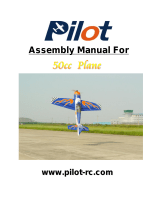phenolic hinge plates. Be careful inserting the hinge wires,
and if they are a bit stiff, then use a little grease on the wire.
Don’t use too much force, otherwise some of the phenolic
plates inside might break loose. Leave the hinge wires a bit
too long during construction, and only cut them off to exact
length when the model is finished.
Fit the servos into the stabs. The mounting plates are
installed for a standard sized servo, just slide the servo in
from the root and secure with the usual screws. You will
need to drill an 8mm hole in the rib about 15mm in front of
the servo for the servo cable and connector. Because of
the thin stab profile you have to install servo arms through
the slots in the btm. of the stab, and you might need to
make the slots 1mm wider if using C-ARF servo arms.
Next the elevator horns. The milled slots in the elevators
should be 15 mm long and 15 mm deep, and may need to
be lengthened towards the Trailing Edge a little bit. Adjust
as necessary. Put a layer of masking tape over the milled
slot, wax it carefully, and then cut out the hole to access the
slot with a sharp knife. Place a strip of masking tape on the
btm. surface of the elevator, and mark on it the exact posi-
tion of the hinge axis.
Make the horn alignment template from thin scrap plywood
(see photo) and mark the position for the quick-link hole in
the horn exactly perpendicular to the hinge axis line on the
tape. The hole should be 22 mm from the surface of the ele-
vator. Drill a 1.5 mm Ø hole in the alignment template, and
glue in a short piece of 1.5 mm wire with a drop of thin CA.
The standard C-ARF phenolic elevator horns need a small
modification for the 2.3m Extra elevators only. Cut, or sand,
a small angled piece off the bottom of each elevator horn
as seen in the photo, and re-drill a 3 mm diameter hole
where shown. This hole is to give a better mechanical fix-
ing when gluing the horn in place. Trial fit the horn in the
slot, and make sure that the wire in the alignment template fits in the hole that is milled in the
horn. Mark the part of the horn that will be glued inside the elevator, and then remove it and scuff
up both sides with coarse (60 grit) sandpaper or a Permagrit tool. Protect the alignment template
with clear plastic tape so that it does not get glued to the horn or elevator!
Glue the horn in place with slow epoxy (minimum 1hr cure) mixed with a little milled fibreglass,
or a filled thixotropic epoxy like Loctite/Hysol 9462 or BVM Aeropoxy. Check that horn is at 90°
to the surface of the elevator, and wipe excess glue off before cure. Repeat for the other eleva-
tor horn, and use this same method described above for the aileron horns, making sure that all
of them are exactly the same distance from the hinge axis to ensure that control surface move-
ments are the same.
Servo choice: The elevators can travel more than 50 degrees, and it is up to you whether you
want to use this throw or not. The throw defines the kind of servo. If you are going to use the
maximum throw for 3D manoeuvres, we definitely recommend digital servos like JR8411, or the
Composite-ARF Extra 330L (2.3m span)
17
(above) Shows horn alignment
template made from scrap ply,
and both standard and modified
C-ARF control surface horns.
(above) Shows C-ARF servo arm
glued and screwed onto standard
25mm diameter servo output arm.






















